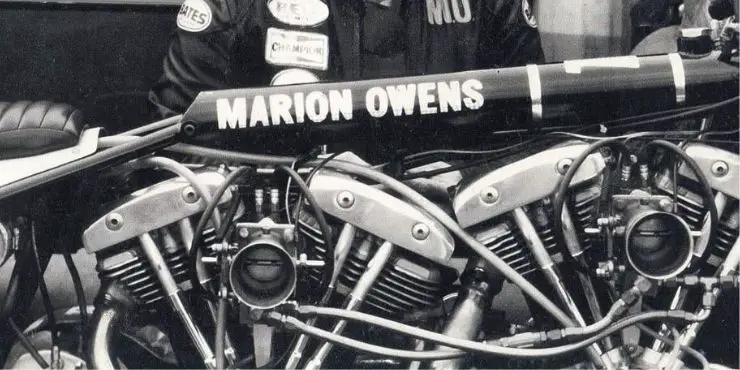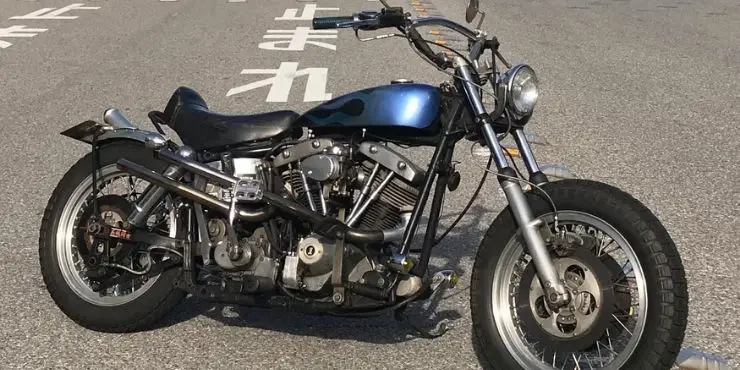Have you heard terms like “Panhead” and “Shovelhead” thrown around by bikers, and you don’t know what they’re talking about? If so, then don’t worry, you’ll get to know all about such terms here.
It’s called a shovelhead as the heads resemble the curve of a shovel. This type of engine is comparatively difficult to identify as the shape doesn’t resemble a traditional shovel. Instead, it looks very similar to a coal shovel flipped upside down.
In this article, you’ll get to know all about shovelhead engines, why is it called a shovelhead, its history, and a lot more.
Why is it called a shovelhead engine?
A shovelhead engine is a type of motorcycle engine produced by Harley-Davidson bikes and used between 1966 and 1984. This engine was used as the successor to the previously popular Panhead engine. Harley-Davidson started using the Shovelhead mainly for producing more power for heavier bikes with rear suspensions and electric starts. The shallow chambers in the Shovelhead engines helped with cooling. Moreover, they also worked well with high compression ratios. The shovelhead engine had to go through several updates before it became the vintage engine that Harley-Davidson riders loved.
When the engine was first launched, the Shovelhead had a fairly shallower combustion chamber. It also had a larger valve drop for intake and exhaust, while having stronger valves and pistons. This gave the engine the extra 10 horsepower alongside a very different appearance. The engine ended up gaining the name “Shovelhead” because of the look of the rocker head. These had the appearance of an old coal shovel flipped upside down, which resembled the appearance of a shovel. While it had a few problems earlier on, the new and improved motor helped Harley-Davidson have a 26% sales increase.
Shovelhead engines took over from Panheads
The Panhead and Shovelhead featured fairly similar engines. The major difference between them is that the Shovelhead featured an improved top-end mounted on the Panhead crankcase. Both of them were two-cylinder, 4-valve V-Twin engines. Harley-Davidson manufactured the Panhead engines from 1948 to 1965 while Shovelhead engines were used between 1966 and 1984. The Panhead got its name due to the rocker box cover resembling inverted baking pans. Meanwhile, the shovelhead nickname was used due to its striking coal shovel-like appearance.
Harley-Davidson decided to replace the Knucklehead V-Twin engine in 1948 with the new Panhead engines. The Knucklehead was a strong, reliable replacement for the Flathead V-Twin engines in 1936. However, the Knucklehead became a messy engine with a reputation for oil leaks. Harley-Davidson resolved this issue by moving the engine’s external oil feeds inside the engine case and introducing the Panhead. The newly launched engine had cubic inch displacements of 61 and 74 inches, but the former was dropped in 1953.
The key difference between the Panhead engine and the Knucklehead engine was the brand replacing the iron cylinders with aluminum allowed for reducing the weight and dissipating the engine heat better. The new Panhead even had hydraulic lifters for reducing noise and downtime for maintenance. The engine had a similar output as the Knucklehead at 50 horsepower. It was further boosted in 1956 to 55 horsepower.
Shovelhead debuts and takes over from the Panhead
The Shovelhead arrived in 1966 as Harley-Davidson tried phasing out the kick-starter and introduced the electric starter. The shovelhead featured the same 74-cubic inch displacement as the Panhead. Harley-Davidson also enlarged the Shovelhead to 82 cubic inches in 1978. The Shovelhead was largely an improved version of the previously used Panhead. It did feature 10% more power than the Panhead. Every Shovelhead model kept the lower style of the Panhead engine, but was bolted on a new top end. The 1966 Electra Glide replaced the Panhead in favor of the new Shovelhead. It became the first Harley-Davidson bike to be powered by a Shovelhead engine.

Changes to the shovelhead
Harley-Davidson added a new top to the Shovelhead by using new alloy cylinder heads with iron cylinder barrels. The brand also replaced the Panhead’s pressed steel rocker boxes with the new ones made from light alloy. In 1970, the Shovelhead’s bottom end from the Panhead was removed and replaced by a new design. This design featured a crankshaft-mounted alternator, giving the bike a slightly wider look. Harley-Davidson also removed the external ignition points assembly in the engine’s timing case. This needed a cone-shaped cover, which altered the look of the Shovelhead.
Did the introduction of Shovelhead save Harley-Davidson from bankruptcy?
One of the toughest things for any legacy company is to keep up with the times. This is exactly what Harley-Davidson was struggling with in the early 60s. In fact, the brand found itself in an era of powerful and increasingly more reliable Japanese competition. Their owners also wanted a share of this new era of bikes. The way Harley-Davidson went about this major change is what got them into a sticky situation.
After an issue with the U.S. Tariff Commission in the 50s, where the family-run brand emerged into the 60s, the bad business decisions and internal drama kept on piling up. In 1961, Harley-Davidson bought Italian brand Aermacchi hoping to take a chunk of the small bike market. This market had continued to elude them all this time. However, the move ended up being a big failure. The Japanese bikes of that era continued wiping the floor with the fake Harley-Davidson bikes.
In 1965, Harley-Davidson ended up going public on the US Stock Exchange. However, this also ended up as a colossal failure because of the poor business decisions within the company. By 1966, the brand was on the brink of bankruptcy and there were offers arriving from all over the world. The struggling company got purchased by American Machine and Foundry (AMF). In those days, AMF was one of the biggest brands that made bowling equipment.
The quality during the AMF era of Harley-Davidson gradually went downhill year after year. This generation was one of the most infamous ones in the entire history of Harley-Davidson. There were very few positions during this era. Throughout this drama and bad business moves, there was the Harley-Davidson Shovelhead engine. The engine was a massive hit and became one of the shining lights at one of the darkest times for the company.
Moreover, Willie G. (The grandson of William A. Davidson) designed the 71 FX Super Glide. This iconic bike went hand in hand with the tremendous success of the Easy Rider movie. The cult film starred Peter Fonda and Dennis Hopper. The Shovelhead, the 71 FX Super Glide, and the movie essentially saved Harley-Davidson. Moreover, they allowed Harley-Davidson to crawl out of the 70s and have a much better 80s.
Design and history of Shovelhead engines
Sticking to your laurels can be an admirable decision. However, if it comes at the price of innovation, it can easily lead to the demise of the brand. The Shovelhead was designed as the successor to the Panhead engine. It made use of numerous interesting choices to achieve more power throughout the engine. As Harley-Davidson bikes became heavier with the addition of features like electric starters, the need for more power was evident. Shovelheads were introduced as the answer. The shovelhead was installed on almost all Harley-Davidson big-twin bikes throughout the almost 20-year production. The Shovelhead also went through several changes over these years.
Most of the shovelhead engines were relative clones of the Panhead engines that came before them. However, the only exception was the head, which gave the shovel its nickname. The shovels weren’t just a headcover as seen on the Panhead. Instead, they were heads that integrated rocker arm pivot right into the casing. Inside, the combination chamber was designed to be more shallow and have a larger drop for the exhaust and intake.
Moreover, it also came with a better porting design while having stronger engine internals. Harley-Davidson decided to stick with the generator until 1970 when an alternative was designed and added to the shovelhead. In 1971, Zenith-Bendix carburetors began to be used for better overall reliability and increased flow.
1979 and 1980 saw a number of significant changes being made to the shovelhead engine. It started having a new electronic ignition engine, a 5-speed transmission, and rubber mounts for the engine. There was also a switch from the chain drive to the belt drive. The following year, the brand bought its shares back from AMF and made more additions to the engine. The Shovelhead featured improved valve guides, a new oil pump, and lowered compression to have additional reliability. By 1984, the brand was ready to replace the iconic Shovelhead, as Harley-Davidson gradually transitioned to Evolution engines.
Issues and complaints with the Shovelhead engines
Nostalgia always makes things come across better than they were. It would be unfair to leave out the complaints and issues that users had with Shovelhead engines. There were a wide variety of problems that plagued this engine over its long production run.
Firstly, the shovelhead only featured 10 fins for cooling each cylinder, and this led to constant issues with overheating. The shovelhead’s head design also allowed oil to seep into the cylinder heads, sneaking past the valves where it burned with a plume of smoke. There were complications with oiling issues as well. The oil would get pooled in the crankcase, starving the internal components of the vital oil. This often resulted in overheating and sometimes even engine damage.
Once the engine embargo during the mid-70s hit, Shovelhead engines suffered massively. The downfall was evident because of the poor quality of fuel available in the United States. Engine knock was caused by low octane fuels, and it resulted in issues with the shovelheads. These issues ranged from blown head gaskets to engine overheating to damaged head bolts. Once electronic ignition was introduced in 1979, owners started encountering persistent issues with fussy electronic control units.
Harley-Davidson during the AMF era really suffered. If it weren’t for the introduction of Shovelhead design and the 1966-1984 period, things could’ve been much worse for Harley-Davidson.
Conclusion
Thanks for reading. Hopefully, now you know all about the history of Shovelhead engines, their significance, and why is it called a Shovelhead. The Shovelhead got its name due to the head resembling the curve of a shovel. This engine doesn’t actually resemble a traditional shovel, it resembles a coal shovel flipped upside down. Shovelhead engines played a key role in saving the legacy of the Harley-Davidson brand. It proved to be the shining light at a time when the brand was experiencing its darkest days. During the mid-60s, Harley-Davidson was going through a lot of issues, if it wasn’t for the introduction of the Shovelhead design, the brand could have gone bankrupt.

